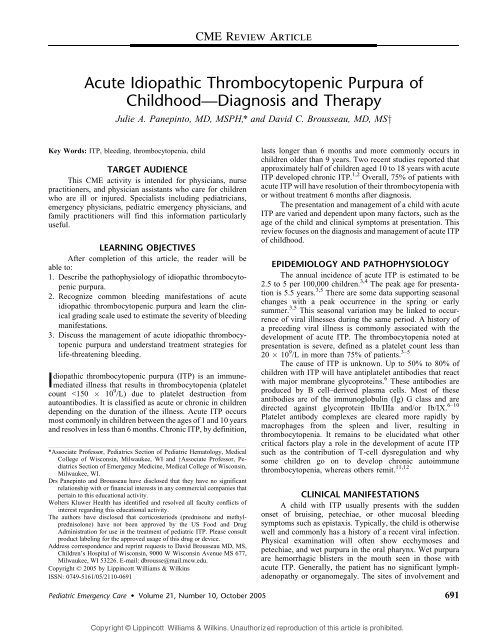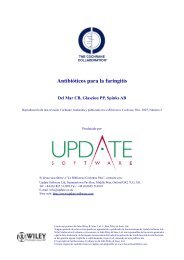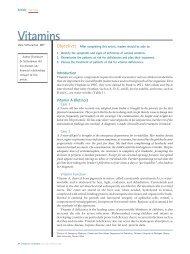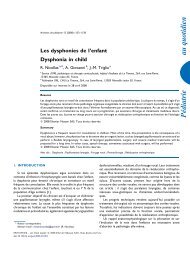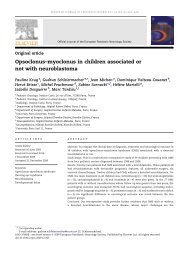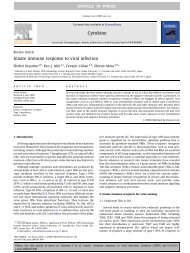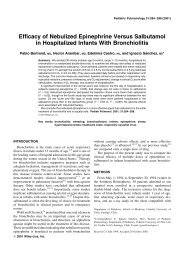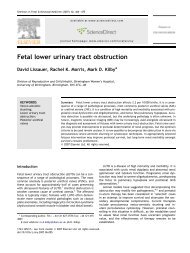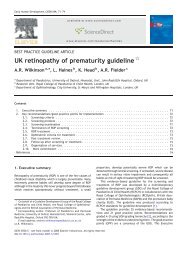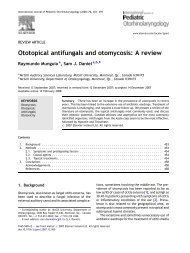Acute Idiopathic Thrombocytopenic Purpura of Childhood ... - sepeap
Acute Idiopathic Thrombocytopenic Purpura of Childhood ... - sepeap
Acute Idiopathic Thrombocytopenic Purpura of Childhood ... - sepeap
Create successful ePaper yourself
Turn your PDF publications into a flip-book with our unique Google optimized e-Paper software.
CME Review Article<br />
<strong>Acute</strong> <strong>Idiopathic</strong> <strong>Thrombocytopenic</strong> <strong>Purpura</strong> <strong>of</strong><br />
<strong>Childhood</strong>—Diagnosis and Therapy<br />
Julie A. Panepinto, MD, MSPH,* and David C. Brousseau, MD, MSy<br />
Key Words: ITP, bleeding, thrombocytopenia, child<br />
TARGET AUDIENCE<br />
This CME activity is intended for physicians, nurse<br />
practitioners, and physician assistants who care for children<br />
who are ill or injured. Specialists including pediatricians,<br />
emergency physicians, pediatric emergency physicians, and<br />
family practitioners will find this information particularly<br />
useful.<br />
LEARNING OBJECTIVES<br />
After completion <strong>of</strong> this article, the reader will be<br />
able to:<br />
1. Describe the pathophysiology <strong>of</strong> idiopathic thrombocytopenic<br />
purpura.<br />
2. Recognize common bleeding manifestations <strong>of</strong> acute<br />
idiopathic thrombocytopenic purpura and learn the clinical<br />
grading scale used to estimate the severity <strong>of</strong> bleeding<br />
manifestations.<br />
3. Discuss the management <strong>of</strong> acute idiopathic thrombocytopenic<br />
purpura and understand treatment strategies for<br />
life-threatening bleeding.<br />
<strong>Idiopathic</strong> thrombocytopenic purpura (ITP) is an immunemediated<br />
illness that results in thrombocytopenia (platelet<br />
count
Panepinto and Brousseau Pediatric Emergency Care Volume 21, Number 10, October 2005<br />
severity <strong>of</strong> bleeding can be used to determine the optimal<br />
approach for a given child.<br />
Some practitioners have begun using clinical grading<br />
scales to assess the severity <strong>of</strong> bleeding. 3,13,14 The grading<br />
consists <strong>of</strong> 4 main categories: asymptomatic, mild, moderate,<br />
and severe. The asymptomatic child has no symptoms in the<br />
setting <strong>of</strong> a low platelet count discovered at the time <strong>of</strong> a<br />
blood count obtained for another reason. Mild ITP is defined<br />
as petechiae and bruising <strong>of</strong> the skin, with or without some<br />
minor epistaxis. Minor epistaxis is defined as bleeding <strong>of</strong><br />
short enough duration that there is no significant change in<br />
the child’s daily activity. Increased bleeding symptoms and<br />
more significant skin and mucosal findings are classified as<br />
moderate ITP. Severe ITP is bleeding that requires immediate<br />
treatment because <strong>of</strong> a significant drop in hemoglobin<br />
or the life-threatening nature <strong>of</strong> the bleeding. Approximately<br />
75% <strong>of</strong> patients have mild symptoms at their initial presentation<br />
<strong>of</strong> ITP, including the majority <strong>of</strong> children with<br />
platelet counts less than 10 10 9 /L. 15 Guidelines using this<br />
clinical grading <strong>of</strong> symptoms were developed in the United<br />
Kingdom to provide a reasonable approach to the management<br />
<strong>of</strong> children with acute ITP. 16<br />
Recently, Buchanan and Adix 13 published a clinical<br />
grading scale that is similar to that developed in the United<br />
Kingdom. Like the United Kingdom scale, there are the<br />
categories <strong>of</strong> asymptomatic, mild, moderate, and severe<br />
hemorrhage. This grading scale also has a minor hemorrhage<br />
category that recognizes very minimal clinical symptoms <strong>of</strong><br />
acute ITP defined as 100 petechiae or less with or without 5 or<br />
fewer bruises and absence <strong>of</strong> mucosal bleeding. In addition,<br />
the grading can be applied to specific sites <strong>of</strong> bleeding, which<br />
include the skin, epistaxis, oral bleeding, and life-threatening<br />
bleeding. This scale, or a variation <strong>of</strong> this and the United<br />
Kingdom grading scale, should prove valuable to determine<br />
the best course <strong>of</strong> therapy related to the severity <strong>of</strong> bleeding in<br />
a child with acute ITP. Consistent grading <strong>of</strong> severity <strong>of</strong><br />
bleeding will also be useful in future ITP research.<br />
There is a large variability in severity <strong>of</strong> bleeding<br />
symptoms in children presenting with acute ITP from no<br />
symptoms to life-threatening hemorrhage. Most commonly,<br />
children with ITP present with skin and mild mucosal<br />
bleeding symptoms.<br />
DIAGNOSIS AND DIFFERENTIAL DIAGNOSIS<br />
ITP is a diagnosis <strong>of</strong> exclusion. Patients have thrombocytopenia<br />
(platelet count
Pediatric Emergency Care Volume 21, Number 10, October 2005<br />
<strong>Acute</strong> <strong>Idiopathic</strong> <strong>Thrombocytopenic</strong> <strong>Purpura</strong><br />
TABLE 1. Treatment for <strong>Acute</strong> <strong>Idiopathic</strong> <strong>Thrombocytopenic</strong> <strong>Purpura</strong><br />
Treatment<br />
Dosing<br />
Time to Increase<br />
in Platelet Count<br />
Observation N/A 3–4 wk N/A<br />
Corticosteroid<br />
Traditional dose<br />
1–2 mg/kg per<br />
d for 7–21 d<br />
Complications<br />
<strong>of</strong> Treatment<br />
3–10 d Behavioral changes,<br />
glucosuria, hypertension,<br />
osteopenia, increase in<br />
appetite and weight gain<br />
High dose 4 mg/kg per d for 4 d 2–4 d<br />
IVIg 0.8–1 g/kg IV for 1–2 d 24 h Fever, nausea, vomiting,<br />
chills, headache, aseptic<br />
meningitis<br />
Anti-D immunoglobulin 50–75 mg/kg IV for 1–2 d 24–48 h Fever, nausea, vomiting,<br />
chills, myalgias, hemolysis<br />
N/A indicates not applicable.<br />
corticosteroids includes decreased clearance <strong>of</strong> the antibodyplatelet<br />
complex and impaired phagocytosis <strong>of</strong> platelets. 27–31<br />
Early studies <strong>of</strong> corticosteroids used to treat acute ITP<br />
showed that there was some benefit when given in low doses<br />
over longer periods compared with placebo. This traditional<br />
dosing was 1 to 2 mg/kg <strong>of</strong> oral prednisone per day for 1 to 3<br />
weeks. 32,33 Time to an increase in platelet count varied from<br />
3 to 10 days. This dose is well tolerated and not usually<br />
associated with significant side effects if it is tapered or<br />
discontinued within a month. However, this is not commonly<br />
used at presentation <strong>of</strong> acute ITP because <strong>of</strong> the longer time<br />
it takes to see platelet recovery. Higher dose steroids given<br />
for a short period have recently been shown to be effective at<br />
raising the platelet count within 2 to 4 days. 34–36 The dose <strong>of</strong><br />
corticosteroids given varied across the studies and ranged<br />
between 4 mg/kg per day to 30 mg/kg per day <strong>of</strong> prednisone<br />
or methylprednisolone for up to 4 days. There were no undue<br />
side effects noted when a dose <strong>of</strong> 4 mg/kg per day for 4 days<br />
orally was used. 34<br />
The benefits <strong>of</strong> using corticosteroids are the relative<br />
ease <strong>of</strong> administration in an outpatient or inpatient setting,<br />
the low cost compared with other treatments, and the absence<br />
<strong>of</strong> exposure to human plasma. The longer time to platelet<br />
increase, however, precludes the use <strong>of</strong> steroids alone to treat<br />
patients who may have moderate or more severe bleeding<br />
symptoms at presentation. High-dose corticosteroids are<br />
effective initial therapy for acute ITP and are used with some<br />
frequency. The Intercontinental <strong>Childhood</strong> ITP Study Group<br />
reported recently that approximately 25% to 40% <strong>of</strong> children<br />
in their registry received corticosteroids as initial therapy<br />
when they presented with acute ITP. 1 The relationship <strong>of</strong><br />
bleeding symptoms or dose <strong>of</strong> corticosteroids used was not<br />
presented in this observational study.<br />
Intravenous Ig<br />
The third treatment option is intravenous (IV)Ig. IVIg<br />
is thought to work, in part, by causing a temporary but<br />
prolonged blockade <strong>of</strong> the Fc receptor <strong>of</strong> the phagocyte that<br />
mediates immune clearance. 31,37,38 This blockade leads to a<br />
compensatory increase in the platelet count. Recently, IVIg<br />
has been shown in a mouse model to more specifically act by<br />
causing up-regulation <strong>of</strong> the inhibitory receptor FcgRIIb to<br />
cause blockade <strong>of</strong> Fc receptors on splenic macrophages. 39,40<br />
There are a variety <strong>of</strong> doses <strong>of</strong> IVIg that may be used, but,<br />
most commonly, the dose given is 0 .8 to 1.0 g/kg daily for 1 to<br />
2 days. 41–45 Given at this dose, IVIg leads to a rapid increase in<br />
platelet count as early as 24 hours after infusion and has been<br />
effective when used for moderate or severe bleeding in acute<br />
ITP. The side effects associated with IVIg are fever, chills,<br />
headache, nausea, vomiting, and aseptic meningitis. There is<br />
also the small risk <strong>of</strong> an infectious complication as IVIg is an<br />
albumin-containing product. Most <strong>of</strong>ten, IVIg, which is<br />
usually administered over 4 to 6 hours or more, is given in a<br />
hospital setting and requires more resources and cost to<br />
administer than corticosteroids. However, it is commonly<br />
used at first presentation <strong>of</strong> acute ITP.<br />
Anti-D Ig<br />
Anti-D Ig, which is purified human IgG directed at the<br />
erythrocyte D antigen, has more recently been used to treat<br />
acute ITP in children who are nonsplenectomized and who<br />
have rhesus-positive (Rh + ) red blood cells. 43,46,47 The<br />
mechanism <strong>of</strong> action <strong>of</strong> anti-D is similar to IVIg in that it<br />
decreases the clearance <strong>of</strong> platelets. More specifically, anti-D<br />
binds to the Rh + red blood cell and sensitizes it to bind to the<br />
macrophage Fc receptor and thereby promotes its clearance by<br />
the spleen. 31,48 This frees platelet-antibody complexes from<br />
being trapped. 48 Higher doses <strong>of</strong> anti-D (50–75 mg/kg) have<br />
been shown to be the most effective at increasing the platelet<br />
count within 24 to 48 hours similar to IVIg. 46,47,49,50 Anti-D is<br />
given IV over 15 to 30 minutes and thus can be easily administered<br />
in an outpatient or emergency department setting. It<br />
has also been shown to be less costly than an equivalent dose<br />
<strong>of</strong> IVIg. 51 The side effects <strong>of</strong> anti-D include headache, fever,<br />
chills, nausea, and vomiting and myalgias. 52 In addition, anti-<br />
D causes hemolysis and a transient decrease in the hemoglobin<br />
n 2005 Lippincott Williams & Wilkins 693<br />
Copyright © Lippincott Williams & Wilkins. Unauthorized reproduction <strong>of</strong> this article is prohibited.
Panepinto and Brousseau Pediatric Emergency Care Volume 21, Number 10, October 2005<br />
secondary to the immune-mediated removal <strong>of</strong> decoded<br />
erythrocytes. This results in a decrease in the hemoglobin,<br />
on average, from 1 to 2 g/dL. 52 Anti-D has also been shown in<br />
rare circumstances to result in hemoglobinemia and/or<br />
hemoglobinuria and renal insufficiency. 53 Like IVIg, anti-D<br />
is a blood product and thus has the potential to transmit<br />
pathogens despite viral inactivation steps that are used.<br />
Treatment <strong>of</strong> Life-threatening Bleeding<br />
Serious bleeding that may be life-threatening, such as an<br />
intracranial hemorrhage, is rare in children with acute ITP but<br />
requires emergent treatment when it occurs. The treatment<br />
should not be delayed for computed tomography scanning if a<br />
computed tomography scan is not immediately available and<br />
the suspicion for bleeding is high. This treatment should<br />
consist <strong>of</strong> corticosteroids in high doses (30 mg/kg per day<br />
<strong>of</strong> IV methylprednisolone for 3 days), IVIg, and platelet<br />
transfusions. 16,21 In addition, a splenectomy, which results<br />
in an immediate rapid rise in the platelet count, should<br />
strongly be considered in situations such as an intracranial<br />
hemorrhage. Although platelet transfusions are not routinely<br />
used in acute ITP because circulating antibody will also bind<br />
transfused platelets, transfused platelets can be helpful<br />
temporarily to gain control <strong>of</strong> bleeding even in the absence<br />
<strong>of</strong> a concomitant rise in the platelet count. Other sites <strong>of</strong><br />
bleeding that may become life-threatening are gastrointestinal<br />
or genitourinary bleeding or severe mucocutaneous bleeding.<br />
In addition, a packed red blood cell transfusion should be<br />
given to children who experience significant bleeding that<br />
results in a decrease in their hemoglobin concentration.<br />
Prognosis<br />
Prognosis for acute ITP is excellent, especially for those<br />
children younger than 10 years. In addition to having a 75%<br />
chance <strong>of</strong> resolution <strong>of</strong> the acute ITP within the first 6 months<br />
<strong>of</strong> presentation, serious bleeding complications are uncommon<br />
in children with acute ITP. 1,13,54 One study reported that<br />
only 17% <strong>of</strong> patients had enough bleeding with ITP to result in<br />
a drop in hemoglobin or to require intervention such as nasal<br />
packing or cautery for epistaxis. 54 The incidence <strong>of</strong> the most<br />
severe complication, intracranial hemorrhage, is very rare and<br />
estimated to be between 0.1% and 0.9%. 1,24–26 In the majority<br />
<strong>of</strong> patients who developed an intracranial bleed, the platelet<br />
count was less than 20 10 9 /L, and they had received some<br />
form <strong>of</strong> treatment before developing the bleed. 24–26 The<br />
mortality rate in the studies reporting intracranial hemorrhage<br />
varied from 0% to 55%. 1,24–26<br />
CONCLUSIONS<br />
<strong>Acute</strong> ITP is generally a benign diagnosis that can be<br />
approached with careful observation and education <strong>of</strong> patient<br />
and family. For children with more serious bleeding<br />
symptoms, there are effective treatment options that will<br />
cause an increase in the platelet count within 1 to 2 days. The<br />
majority <strong>of</strong> children diagnosed with acute ITP will go on to<br />
complete resolution <strong>of</strong> the disease within 6 months with no<br />
further sequelae. Further work using clinical grading scales<br />
for bleeding to predict outcome, direct treatment, and<br />
promote the development <strong>of</strong> new therapies will continue to<br />
advance the care <strong>of</strong> children with acute ITP.<br />
REFERENCES<br />
1. Kuhne T, Buchanan GR, Zimmerman S, et al. A prospective<br />
comparative study <strong>of</strong> 2540 infants and children with newly diagnosed<br />
idiopathic thrombocytopenic purpura (ITP) from the Intercontinental<br />
<strong>Childhood</strong> ITP Study Group. J Pediatr. 2003;143(5):605–608.<br />
2. Lowe EJ, Buchanan GR. <strong>Idiopathic</strong> thrombocytopenic purpura diagnosed<br />
during the second decade <strong>of</strong> life. J Pediatr. 2002;141(2):253–258.<br />
3. Sutor AH, Harms A, Kaufmehl K. <strong>Acute</strong> immune thrombocytopenia<br />
(ITP) in childhood: retrospective and prospective survey in Germany.<br />
Semin Thromb Hemost. 2001;27(3):253–267.<br />
4. Zeller B, Helgestad J, Hellebostad M, et al. Immune thrombocytopenic<br />
purpura in childhood in Norway: a prospective, population-based registration.<br />
Pediatr Hematol Oncol. 2000;17(7):551–558.<br />
5. Kuhne T, Imbach P, Bolton-Maggs PH, et al. Newly diagnosed idiopathic<br />
thrombocytopenic purpura in childhood: an observational study.<br />
Lancet. 2001;358(9299):2122–2125.<br />
6. Berchtold P, McMillan R, Tani P, et al. Autoantibodies against platelet<br />
membrane glycoproteins in children with acute and chronic immune<br />
thrombocytopenic purpura. Blood. 1989;74(5):1600–1602.<br />
7. Escher R, Muller D, Vogel M, et al. Recombinant human natural<br />
autoantibodies against GpIIb/IIIa inhibit binding <strong>of</strong> autoantibodies from<br />
patients with AITP. Br J Haematol. 1998;102(3):820–828.<br />
8. Hou M, Stockelberg D, Kutti J, et al. Antibodies against platelet<br />
GpIb/IX, GpIIb/IIIa, and other platelet antigens in chronic idiopathic<br />
thrombocytopenic purpura. Eur J Haematol. 1995;55(5):307–314.<br />
9. Hou M, Stockelberg D, Kutti J, et al. Immunoglobulins targeting both<br />
GpIIb/IIIa and GpIb/IX in chronic idiopathic thrombocytopenic purpura<br />
(ITP): evidence for at least two different IgG antibodies. Br J Haematol.<br />
1997;98(1):64–67.<br />
10. Kiefel V, Santoso S, Kaufmann E, et al. Autoantibodies against platelet<br />
glycoprotein Ib/IX: a frequent finding in autoimmune thrombocytopenic<br />
purpura. Br J Haematol. 1991;79(2):256–262.<br />
11. Imbach PA, Kuhne T, Hollander G. Immunologic aspects in the<br />
pathogenesis and treatment <strong>of</strong> immune thrombocytopenic purpura in<br />
children. Curr Opin Pediatr. 1997;9(1):35–40.<br />
12. Ware RE, Howard TA. Phenotypic and clonal analysis <strong>of</strong> T lymphocytes<br />
in childhood immune thrombocytopenic purpura. Blood. 1993;82(7):<br />
2137–2142.<br />
13. Buchanan GR, Adix L. Grading <strong>of</strong> hemorrhage in children with<br />
idiopathic thrombocytopenic purpura. J Pediatr. 2002;141(5):683–688.<br />
14. Bolton-Maggs P. Severe bleeding in idiopathic thrombocytopenic<br />
purpura. J Pediatr Hematol Oncol. 2003;25(suppl 1):S47–51.<br />
15. Bolton-Maggs PH, Moon I. Assessment <strong>of</strong> UK practice for management<br />
<strong>of</strong> acute childhood idiopathic thrombocytopenic purpura against published<br />
guidelines. Lancet. 1997;350(9078):620–623.<br />
16. Guidelines for the investigation and management <strong>of</strong> idiopathic thrombocytopenic<br />
purpura in adults, children and in pregnancy. Br J<br />
Haematol. 2003;120(4):574–596.<br />
17. Calpin C, Dick P, Poon A, et al. Is bone marrow aspiration needed in<br />
acute childhood idiopathic thrombocytopenic purpura to rule out leukemia?<br />
Arch Pediatr Adolesc Med. 1998;152(4):345–347.<br />
18. Vesely S, Buchanan GR, Cohen A, et al. Self-reported diagnostic and<br />
management strategies in childhood idiopathic thrombocytopenic purpura:<br />
results <strong>of</strong> a survey <strong>of</strong> practicing pediatric hematology/oncology<br />
specialists. J Pediatr Hematol Oncol. 2000;22(1):55–61.<br />
19. Cines DB, Bussel JB, McMillan RB, et al. Congenital and acquired<br />
thrombocytopenia. Hematology. 2004:390–406.<br />
20. Young G, Luban N, White JG. Giant platelet disorders in African-<br />
American children misdiagnosed as idiopathic thrombocytopenic<br />
purpura. J Pediatr Hematol Oncol. 1999;21(3):231–236.<br />
21. George JN, Woolf SH, Raskob GE, et al. <strong>Idiopathic</strong> thrombocytopenic<br />
purpura: a practice guideline developed by explicit methods for the<br />
American Society <strong>of</strong> Hematology. Blood. 1996;88(1):3–40.<br />
22. Charles KS, Chamely S, Koppada A, et al. Medical nemesis and<br />
694 n 2005 Lippincott Williams & Wilkins<br />
Copyright © Lippincott Williams & Wilkins. Unauthorized reproduction <strong>of</strong> this article is prohibited.
Pediatric Emergency Care Volume 21, Number 10, October 2005<br />
<strong>Acute</strong> <strong>Idiopathic</strong> <strong>Thrombocytopenic</strong> <strong>Purpura</strong><br />
childhood idiopathic thrombocytopenic purpura. Br J Haematol. 2004;<br />
126(2):282–283. author reply, p283.<br />
23. Imbach P, Kuhne T, Zimmerman S. New developments in idiopathic<br />
thrombocytopenic purpura (ITP): cooperative, prospective studies by the<br />
Intercontinental <strong>Childhood</strong> ITP Study Group. J Pediatr Hematol Oncol.<br />
2003;25(suppl 1):S74–76.<br />
24. Butros LJ, Bussel JB. Intracranial hemorrhage in immune thrombocytopenic<br />
purpura: a retrospective analysis. J Pediatr Hematol Oncol.<br />
2003;25(8):660–664.<br />
25. Iyori H, Bessho F, Ookawa H, et al. Intracranial hemorrhage in children<br />
with immune thrombocytopenic purpura. Japanese Study Group on<br />
childhood ITP. Ann Hematol. 2000;79(12):691–695.<br />
26. Lilleyman JS. Intracranial haemorrhage in idiopathic thrombocytopenic<br />
purpura. Paediatric Haematology Forum <strong>of</strong> the British Society for<br />
Haematology. Arch Dis Child. 1994;71(3):251–253.<br />
27. McMillan R, Longmire RL, Tavassoli M, et al. In vitro platelet<br />
phagocytosis by splenic leukocytes in idiopathic thrombocytopenic<br />
purpura. N Engl J Med. 1974;290(5):249–251.<br />
28. Shulman NR, Marder VJ, Weinrach RS. Similarities between known<br />
antiplatelet antibodies and the factor responsible for thrombocytopenia<br />
in idiopathic purpura. Physiologic, serologic and isotopic studies. Ann<br />
N Y Acad Sci. 1965;124(2):499–542.<br />
29. Branehog I, Weinfeld A. Platelet survival and platelet production in<br />
idiopathic thrombocytopenic purpura (ITP) before and during treatment<br />
with corticosteroids. Scand J Haematol. 1974;12(1):69–79.<br />
30. Handin RI, Stossel TP. Effect <strong>of</strong> corticosteroid therapy on the<br />
phagocytosis <strong>of</strong> antibody-coated platelets by human leukocytes. Blood.<br />
1978;51(5):771–779.<br />
31. Cines DB, McKenzie SE, Siegel DL. Mechanisms <strong>of</strong> action <strong>of</strong><br />
therapeutics in idiopathic thrombocytopenic purpura. J Pediatr Hematol<br />
Oncol. 2003;25(suppl 1):S52–56.<br />
32. Buchanan GR, Holtkamp CA. Prednisone therapy for children with<br />
newly diagnosed idiopathic thrombocytopenic purpura. A randomized<br />
clinical trial. Am J Pediatr Hematol Oncol. 1984;6(4):355–361.<br />
33. Sartorius JA. Steroid treatment <strong>of</strong> idiopathic thrombocytopenic purpura<br />
in children. Preliminary results <strong>of</strong> a randomized cooperative study. Am<br />
J Pediatr Hematol Oncol. 1984;6(2):165–169.<br />
34. Carcao MD, Zipursky A, Butchart S, et al. Short-course oral prednisone<br />
therapy in children presenting with acute immune thrombocytopenic<br />
purpura (ITP). Acta Paediatr Suppl. 1998;424:71–74.<br />
35. van H<strong>of</strong>f J, Ritchey AK. Pulse methylprednisolone therapy for acute<br />
childhood idiopathic thrombocytopenic purpura. J Pediatr. 1988;113(3):<br />
563–566.<br />
36. Jayabose S, Patel P, Inamdar S, et al. Use <strong>of</strong> intravenous methylprednisolone<br />
in acute idiopathic thrombocytopenic purpura. Am J Pediatr<br />
Hematol Oncol. 1987;9(2):133–135.<br />
37. Bussel JB, Kimberly RP, Inman RD, et al. Intravenous gammaglobulin<br />
treatment <strong>of</strong> chronic idiopathic thrombocytopenic purpura. Blood. 1983;<br />
62(2):480–486.<br />
38. Fehr J, H<strong>of</strong>mann V, Kappeler U. Transient reversal <strong>of</strong> thrombocytopenia<br />
in idiopathic thrombocytopenic purpura by high-dose intravenous<br />
gamma globulin. N Engl J Med. 1982;306(21):1254–1258.<br />
39. Samuelsson A, Towers TL, Ravetch JV. Anti-inflammatory activity<br />
<strong>of</strong> IVIG mediated through the inhibitory Fc receptor. Science. 2001;<br />
291(5503):484–486.<br />
40. Crow AR, Song S, Freedman J, et al. IVIg-mediated amelioration <strong>of</strong><br />
murine ITP via FcgammaRIIB is independent <strong>of</strong> SHIP1, SHP-1, and<br />
Btk activity. Blood. 2003;102(2):558–560.<br />
41. Duru F, Fisgin T, Yarali N, et al. Clinical course <strong>of</strong> children with<br />
immune thrombocytopenic purpura treated with intravenous immunoglobulin<br />
G or megadose methylprednisolone or observed without<br />
therapy. Pediatr Hematol Oncol. 2002;19(4):219–225.<br />
42. Blanchette VS, Luke B, Andrew M, et al. A prospective, randomized<br />
trial <strong>of</strong> high-dose intravenous immune globulin G therapy, oral prednisone<br />
therapy, and no therapy in childhood acute immune thrombocytopenic<br />
purpura. J Pediatr. 1993;123(6):989–995.<br />
43. Blanchette V, Imbach P, Andrew M, et al. Randomised trial <strong>of</strong><br />
intravenous immunoglobulin G, intravenous anti-D, and oral prednisone<br />
in childhood acute immune thrombocytopenic purpura. Lancet. 1994;<br />
344(8924):703–707.<br />
44. Rosthoj S, Nielsen S, Pedersen FK. Randomized trial comparing<br />
intravenous immunoglobulin with methylprednisolone pulse therapy in<br />
acute idiopathic thrombocytopenic purpura. Danish I.T.P. Study Group.<br />
Acta Paediatr. 1996;85(8):910–915.<br />
45. Fujisawa K, Iyori H, Ohkawa H, et al. A prospective, randomized trial<br />
<strong>of</strong> conventional, dose-accelerated corticosteroids and intravenous<br />
immunoglobulin in children with newly diagnosed idiopathic thrombocytopenic<br />
purpura. Int J Hematol. 2000;72(3):376–383.<br />
46. Tarantino MD, Madden RM, Fennewald DL, et al. Treatment <strong>of</strong><br />
childhood acute immune thrombocytopenic purpura with anti-D immune<br />
globulin or pooled immune globulin. J Pediatr. 1999;134(1):21–26.<br />
47. Moser AM, Shalev H, Kapelushnik J. Anti-D exerts a very early<br />
response in childhood acute idiopathic thrombocytopenic purpura.<br />
Pediatr Hematol Oncol. 2002;19(6):407–411.<br />
48. Ware RE, Zimmerman SA. Anti-D: mechanisms <strong>of</strong> action. Semin<br />
Hematol. 1998;35(1 suppl 1):14–22.<br />
49. Newman GC, Novoa MV, Fodero EM, et al. A dose <strong>of</strong> 75 microg/kg/d<br />
<strong>of</strong> i.v. anti-D increases the platelet count more rapidly and for a longer<br />
period <strong>of</strong> time than 50 microg/kg/d in adults with immune thrombocytopenic<br />
purpura. Br J Haematol. 2001;112(4):1076–1078.<br />
50. Monteleone PM, Vander Heyden MA, Steele DA, et al. Anti-D immunoglobulin<br />
in children with newly diagnosed immune thrombocytopenic<br />
purpura: a pilot study. Haematologica. 2000;85(8):887–888.<br />
51. Simpson KN, Coughlin CM, Eron J, et al. <strong>Idiopathic</strong> thrombocytopenia<br />
purpura: treatment patterns and an analysis <strong>of</strong> cost associated with<br />
intravenous immunoglobulin and anti-D therapy. Semin Hematol.<br />
1998;35(1 suppl 1):58–64.<br />
52. Hong F, Ruiz R, Price H, et al. Safety pr<strong>of</strong>ile <strong>of</strong> WinRho anti-D. Semin<br />
Hematol. 1998;35(1 suppl 1):9–13.<br />
53. Gaines AR. <strong>Acute</strong> onset hemoglobinemia and/or hemoglobinuria and<br />
sequelae following Rh(o)(D) immune globulin intravenous administration<br />
in immune thrombocytopenic purpura patients. Blood. 2000;<br />
95(8):2523–2529.<br />
54. Medeiros D, Buchanan GR. Major hemorrhage in children with<br />
idiopathic thrombocytopenic purpura: immediate response to therapy<br />
and long-term outcome. J Pediatr. 1998;133(3):334–339.<br />
n 2005 Lippincott Williams & Wilkins 695<br />
Copyright © Lippincott Williams & Wilkins. Unauthorized reproduction <strong>of</strong> this article is prohibited.
Panepinto and Brousseau Pediatric Emergency Care Volume 21, Number 10, October 2005<br />
Instructions for the Pediatric Emergency Care CME Program Examination<br />
To earn CME credit, you must read the designated article and complete the examination below, answering at least 80%<br />
<strong>of</strong> the questions correctly. Mail a photocopy <strong>of</strong> the completed answer sheet to the Office <strong>of</strong> Continuing Education, Wolters<br />
Kluwer Health, 530 Walnut Street, 8th Floor East, Philadelphia, PA 19106. Only the first answer form will be considered for<br />
credit and must be received by Wolters Kluwer Health by December 15, 2005. Answer sheets will be graded and certificates<br />
will be mailed to each participant within six to eight weeks after WKH receipt. The answers for this examination will appear in<br />
the January 2006 issue <strong>of</strong> Pediatric Emergency Care.<br />
Credits<br />
Wolters Kluwer Health designates this educational activity for a maximum <strong>of</strong> 1 category 1 credit toward the AMA<br />
Physician’s Recognition Award. Each physician should claim only those credits that he/she actually spent in the activity.<br />
Accreditation<br />
Wolters Kluwer Health is accredited by the Accreditation Council for Continuing Medical Education to provide<br />
continuing medical education for physicians.<br />
CME EXAMINATION<br />
October 2005<br />
Please mark your answers on the ANSWER SHEET.<br />
<strong>Acute</strong> <strong>Idiopathic</strong> <strong>Thrombocytopenic</strong> <strong>Purpura</strong> <strong>of</strong> <strong>Childhood</strong>—Diagnosis and Therapy, Panepinto and Brousseau<br />
1. The clinical manifestations <strong>of</strong> ITP are due to:<br />
a) altered platelet function<br />
b) decreased production <strong>of</strong> platelets in the bone marrow<br />
c) autoimmune destruction <strong>of</strong> platelets<br />
d) increased consumption <strong>of</strong> platelets from mucosal<br />
bleeding<br />
2. All <strong>of</strong> the following are common signs/symptoms in ITP<br />
except:<br />
a) splenomegaly<br />
b) petechiae<br />
c) ecchymoses<br />
d) hemorrhagic blisters in the mouth<br />
e) epistaxis<br />
3. Which <strong>of</strong> the following treatments would be least appropriate<br />
for a child with ITP and mild to moderate<br />
symptoms?<br />
a) oral corticosteroids<br />
b) IVIg<br />
c) platelet transfusion<br />
d) IV anti-D Ig<br />
4. A child with known ITP presents with the acute onset <strong>of</strong> a<br />
severe headache and focal neurological findings. Which<br />
treatment(s) should be given or strongly considered at this<br />
time?<br />
a) high-dose IV steroids<br />
b) platelet transfusion<br />
c) IVIg<br />
d) splenectomy<br />
e) all <strong>of</strong> the above<br />
5. Which <strong>of</strong> the following is correct about the treatment <strong>of</strong><br />
childhood ITP?<br />
a) Observation is never indicated due to the risk <strong>of</strong><br />
intracranial hemorrhage.<br />
b) Treatment should be based on the platelet count alone.<br />
c) The natural course <strong>of</strong> ITP is a return to normal platelet<br />
count without sequelae.<br />
d) A bone marrow aspiration is required for all children<br />
treated for ITP.<br />
e) Children between 3 and 5 years <strong>of</strong> age have the<br />
highest risk <strong>of</strong> progression to chronic ITP.<br />
696 n 2005 Lippincott Williams & Wilkins<br />
Copyright © Lippincott Williams & Wilkins. Unauthorized reproduction <strong>of</strong> this article is prohibited.
Pediatric Emergency Care Volume 21, Number 10, October 2005<br />
<strong>Acute</strong> <strong>Idiopathic</strong> <strong>Thrombocytopenic</strong> <strong>Purpura</strong><br />
ANSWER SHEET FOR THE PEDIATRIC EMERGENCY CARE<br />
CME PROGRAM EXAM<br />
October 2005<br />
Please answer the questions on page 696 by filling in the appropriate circles on the answer sheet below. Please mark the one<br />
best answer and fill in the circle until the letter is no longer visible. To process your exam, you must also provide the following<br />
information:<br />
Name (please print): ______________________________________________________________________________________<br />
Street Address ___________________________________________________________________________________________<br />
City/State/Zip ___________________________________________________________________________________________<br />
Daytime Phone __________________________________________________________________________________________<br />
Specialty _______________________________________________________________________________________________<br />
1. A B C D E<br />
2. A B C D E<br />
3. A B C D E<br />
4. A B C D E<br />
5. A B C D E<br />
Your evaluation <strong>of</strong> this CME activity will help guide future planning. Please respond to the following questions.<br />
1. Did the content <strong>of</strong> the article(s) meet the stated learning objectives?<br />
[ ] Yes [ ] No<br />
2. On a scale <strong>of</strong> 1 to 5, with 5 being the highest, how do you rank the overall quality <strong>of</strong> this educational activity as it pertains to<br />
your practice?<br />
[]5 []4 []3 []2 []1<br />
3. As a result <strong>of</strong> meeting the learning objectives <strong>of</strong> this educational activity, will you be changing your practice behavior in<br />
a manner that improves your patient care? If yes, please explain.<br />
________________________________________________________________________________________________________<br />
[ ] Yes [ ] No<br />
________________________________________________________________________________________________________<br />
4. Did you perceive any evidence <strong>of</strong> bias for or against any comercial products? If so, please explain.<br />
[ ] Yes [ ] No<br />
________________________________________________________________________________________________________<br />
________________________________________________________________________________________________________<br />
5. Please state one or two topics that you would like to see addressed in future issues.<br />
6. How long did it take you to complete this CME activity?<br />
__________hour(s) __________minutes<br />
Must be Recieved by December 15, 2005 in the<br />
Office <strong>of</strong> Continuing Education<br />
Wolters Kluwer Health<br />
530 Walnut Street, 8th Floor East<br />
Philadelphia, PA 19106<br />
n 2005 Lippincott Williams & Wilkins 697<br />
Copyright © Lippincott Williams & Wilkins. Unauthorized reproduction <strong>of</strong> this article is prohibited.
Panepinto and Brousseau Pediatric Emergency Care Volume 21, Number 10, October 2005<br />
CME EXAM ANSWERS<br />
Answers for the Pediatric Emergency Care CME Program Exam<br />
Below you will find the answers to the examination covering the review article in the July 2005 issue. All participants whose<br />
examinations were postmarked by September 15, 2005 and who achieved a score <strong>of</strong> 80% or greater will receive a certificate<br />
from Wolters Kluwer Health.<br />
EXAM ANSWERS<br />
July 2005<br />
1. B<br />
2. C<br />
3. D<br />
4. C<br />
5. D<br />
698 n 2005 Lippincott Williams & Wilkins<br />
Copyright © Lippincott Williams & Wilkins. Unauthorized reproduction <strong>of</strong> this article is prohibited.


